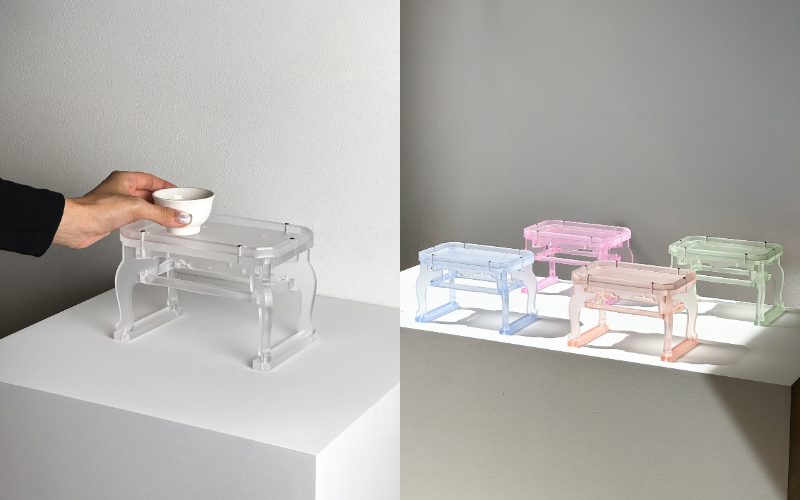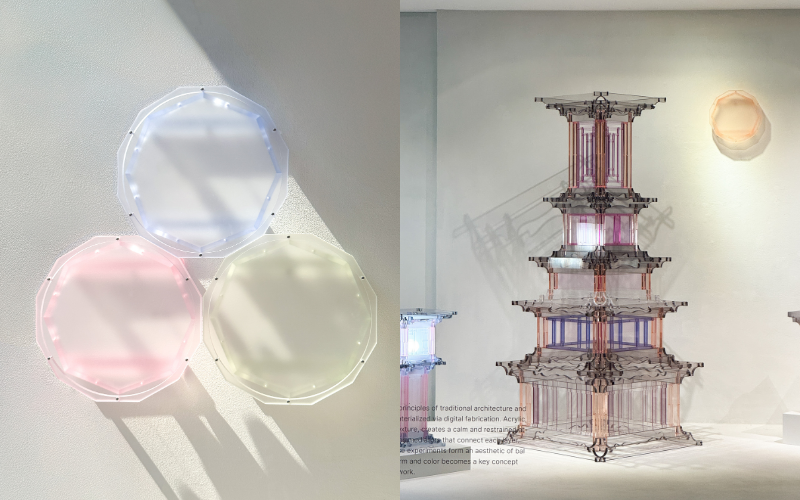Seongsoo Kim, a Korean artist, creates handcrafted works that balance functionality and aesthetics using acrylic and metal as his main materials. He reinterprets the traditional Korean Soban, a small portable table for dining or tea, through modern materials such as acrylic and metal, maintaining its balance of function and aesthetics.
His exhibitions include "Accumulated Forms" at the KCDF Window Gallery (Oct 29 – Nov 23, 2025), "Once Upon a Time in Korea, When Tigers Smoked Pipes" at Giagaga Gallery in Seoul (Oct 24 – Nov 8, 2025), and the "New Soban" exhibition at Hitoki in Osaka, Japan (2023) and many others.
What captivates me about his Soban designs is the way he merges clear, see-through materials with contemporary interpretations of traditional Korean furnitures.
Below are excerpts from an email interview with him from Oct 30 to Nov 3, about his Soban art.

1. What drew you to the traditional Korean Soban as a source of inspiration?
While studying assembly structures, I looked into how traditional Korean furniture and small wooden objects were made. I discovered that the wooden Soban, a traditional portable table, could also be realized in acrylic while retaining its essence. Traditional Soban were designed for a floor-sitting lifestyle, which makes them somewhat impractical in modern contexts. By lowering the height and treating it more like a tray, I was able to reinterpret it into a form that suits contemporary living.
2. Why did you choose acrylic and other transparent materials for your designs?
Acrylic is an incredibly appealing material. It can be colored while maintaining transparency, and when sanded to a semi-transparent finish, it gives off a soft, warm impression. I’m drawn to how light interacts with the material, revealing its structure yet creating subtle depth.
3. What’s the process for your designs?
My design process usually begins with digital drafting using software like Rhino and AutoCAD. I repeat the process of drawing and revising until the structure feels right, then create rendered images to visualize how the piece will look in real life before moving on to fabrication.

4. Can you share the story behind some of your works?
Through the process of creating Soban, I became deeply interested in traditional Korean design and structural principles. For example, my work "Baesaek Table" was inspired by the Seoan, a scholar’s desk used during the Joseon Dynasty. More recently, "Cheongjeokru" and "Baesaek Lantern" drew inspiration from the wooden and stone pagodas found in Korean temples. A pagoda is a symbolic structure that embodies human hopes and spiritual aspirations. For me, "Cheongjeokru" represents a tower built upon my own wishes, determination, and personal devotion.
5. Are there specific Korean design principles that guide your work?
Yes. The fundamental principle behind all my works is the interlocking joint technique, where two components are fitted together to form a column or beam. This method was widely used in traditional Korean wooden architecture, and I reinterpret the simplest forms of these joinery techniques in my own structural designs.

6. Are there other traditional Korean objects you hope to reinterpret in your future projects?
Rather than small objects, I’m increasingly interested in architectural or sculptural forms. I want to study traditional structures or monuments that have been lost to war or time and reinterpret them in my own way; creating scaled, reconstructed models that bring their essence into a new, contemporary context.
His designs reflect a thoughtful balance of tradition, modernity, and aesthetic expression, inviting viewers to experience everyday objects in a new, sculptural way.
How about this article?
- Like4
- Support0
- Amazing0
- Sad0
- Curious0
- Insightful0


